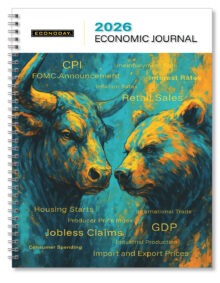Global economic data are coming in just below Econoday’s consensus medians, at minus 12 for the overall Relative Performance Index (RPI) and at minus 11 less prices (RPI-P). These readings have been little changed for the past month suggesting that the marginal bias to Econoday’s global policy rate, currently at a weighted average of 4.3 percent for major central banks, is to the downside.
Ahead of Thursday’s Bank of England announcement, UK economic data have begun to struggle to keep up with market forecasts. Even so, at minus 6 and minus 7 respectively, the RPI and RPI-P show only a limited degree of underperformance. Moreover, since the May MPC meeting, both measures have averaged just above zero suggesting no additional pressure to cut Bank Rate.
In Switzerland, the RPI (minus 7) masks a real economy that is running somewhat hotter than expected – the RPI-P stands at 15. The gap means that recent inflation data have surprised on the downside, leaving the door open to another cut for the Swiss National Bank’s policy rate on Thursday. Forecasters are split on whether or not the bank will in fact deliver a second successive ease.
Canadian underperformance, at minus 13 overall, is extending to a third straight month, helping to explain the prior week’s rate cut by the Bank of Canada. Likewise the Eurozone, at minus 19 overall and a lowly minus 33 when excluding prices, likewise explains the ECB’s move.
Japan is performing in line with expectations, at plus 6 overall and minus 5 ex-prices both of which indicate that the country’s data, on net, are posting within Econoday’s consensus ranges. And China right now is performing exactly at Econoday’s median forecasts, at zero for the RPI and at zero for the RPI-P as well. No changes are expected for the country’s loan prime rates on Thursday.
Though inflation in the US is only moderating to a limited degree, price data have nevertheless been coming in below estimates. This is reflected in the separation between the country’s overall score at minus 27 which improves sharply to minus 10 when excluding weaker-than-expected inflation results.

 Econoday’s Global Economics articles detail the results of each week’s key economic events and offer consensus forecasts for what’s ahead in the coming week. Global Economics is sent via email on Friday Evenings.
Econoday’s Global Economics articles detail the results of each week’s key economic events and offer consensus forecasts for what’s ahead in the coming week. Global Economics is sent via email on Friday Evenings. The Daily Global Economic Review is a daily snapshot of economic events and analysis designed to keep you informed with timely and relevant information. Delivered directly to your inbox at 5:30pm ET each market day.
The Daily Global Economic Review is a daily snapshot of economic events and analysis designed to keep you informed with timely and relevant information. Delivered directly to your inbox at 5:30pm ET each market day. Stay ahead in 2026 with the Econoday Economic Journal! Packed with a comprehensive calendar of key economic events, expert insights, and daily planning tools, it’s the perfect resource for investors, students, and decision-makers.
Stay ahead in 2026 with the Econoday Economic Journal! Packed with a comprehensive calendar of key economic events, expert insights, and daily planning tools, it’s the perfect resource for investors, students, and decision-makers.